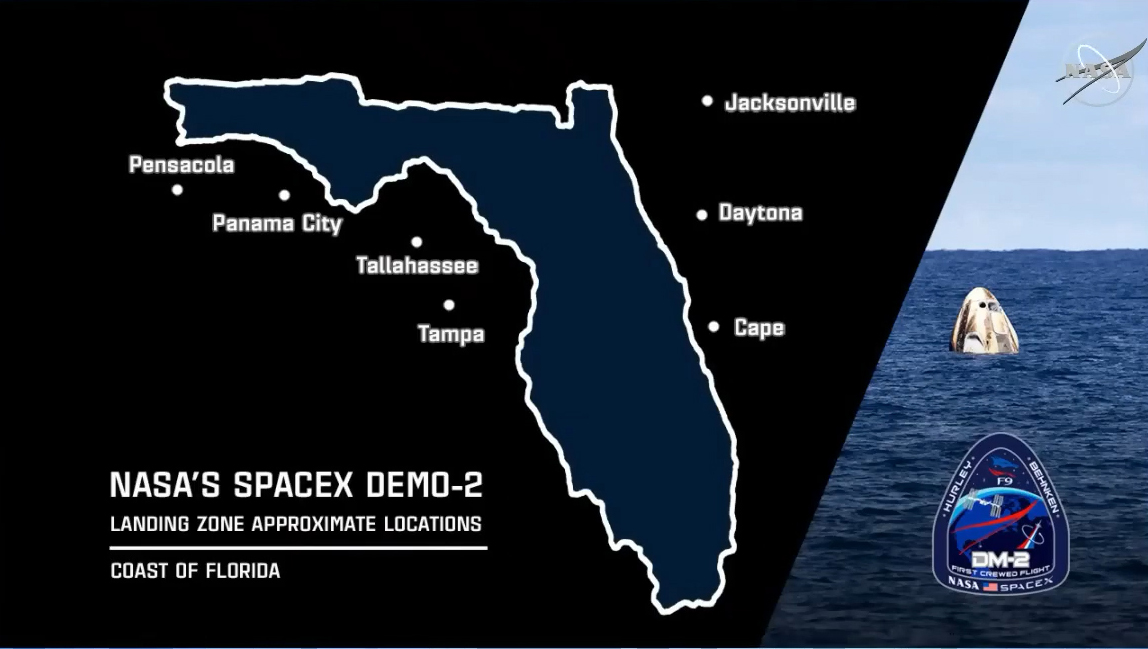NASA astronauts set to ride a SpaceX Crew Dragon back to Earth for the 1st time this weekend
Splashdown is Sunday, Aug. 2. But it depends on Hurricane Isaias.
After a busy two months in space, the first two NASA astronauts to visit the International Space Station on a commercial vehicle are ready to come back to Earth — if the weather cooperates.
Doug Hurley and Bob Behnken arrived at the International Space Station on May 31, the day after becoming the first astronauts to launch from Florida tucked inside a SpaceX Crew Dragon capsule. But this weekend, they have to tackle one of the most challenging aspects of the mission: leaving the space station, spending hours inside that same capsule, parachuting through Earth's atmosphere and splashing down off the coast of Florida.
"It's just time to go give it a try and see how it goes," Hurley said during a news conference on Friday (July 31) held with his colleagues in orbit during his last full day on the space station.
Hurley and Behnken are currently scheduled to climb into the Crew Dragon capsule Saturday (Aug. 1) and splash down on Sunday (Aug. 2). Their initial splashdown target site is in the Gulf of Mexico off the coast of Florida's Panama City, NASA officials have said.
Related: SpaceX's historic Demo-2 Crew Dragon test flight: Full coverage
The splashdown procedure marks the final hurdle of the duo's mission, dubbed Demo-2, and marks the final test for SpaceX's commercial crew system. After a safe return, the company should be clear to launch regular missions to the orbiting laboratory.
Every step of the Demo-2 mission has been an evaluation of the new spacecraft, and both Behnken and Hurley and NASA leadership have emphasized throughout the mission that it has been a test flight. The astronauts' job has been to vet every aspect of the vehicle and ensure it is ready for regular use by crewmembers, but it also means that they have been guinea pigs of a sort throughout the mission, and that holds for their return as well, although the astronauts said they're unfazed.
Breaking space news, the latest updates on rocket launches, skywatching events and more!
"As we get closer, I think we really focus more and more on our preparations to be ready for the splashdown activities," Behnken said. "I still don't feel nervous about it."
For decades, U.S. astronauts returning from space have touched down on land, either in a runway landing like those conducted by NASA's space shuttles or in a parachute landing as the Russian Soyuz capsules do. The last American crew to return to the ocean did so 45 years ago, at the end of the Apollo-Soyuz Test Project mission in which astronauts met up with Soviet cosmonauts in orbit.
"The water landing portion of it is pretty challenging from a physiological standpoint, just after coming back from being in microgravity for on the order of one to two months," Hurley said. "The ground teams are fully aware of the challenges of a water landing and what it does to the human body and we'll just take it from there."
In photos: SpaceX's historic Demo-2 test flight with astronauts
Although NASA is eager to see the Demo-2 capsule undock, the scheduling of the return trip isn't set in stone. NASA and SpaceX will base the timing of the procedure on a host of weather and ocean criteria at whichever of the seven splashdown sites the team ends up targeting.
Right now, those conditions are looking tricky. The National Oceanic and Atmospheric Administration's (NOAA) National Hurricane Center is monitoring a system called Hurricane Isaias as it barrels through the Caribbean Sea, heading toward Florida.
As of this morning, forecasts predict the storm will head up the eastern coast of Florida throughout the day on Sunday, potentially leaving safe conditions on the Gulf coast, where four of the seven potential sites are located.
The astronauts said they're leaving weather concerns to staff on the ground and are ready to do what mission control advises. "We don't control the weather and we know we can stay up here longer," Behnken said. "There's more chow and I know the space station program's got more work that we can do for those [researchers] and other folks that have sent science up here to the space station."
A safe return for Demo-2 is the last piece of the puzzle for NASA approval of SpaceX's next crewed launch, the company's first full-length mission to the space station. Dubbed Crew-1, that mission is currently targeting launch in late September.
Crew-1 will carry three NASA astronauts — Michael Hopkins, Victor Glover and Shannon Walker — and Japan's Soichi Noguchi to the space station for a stay more than six months long that will put the orbiting laboratory's staff count at seven.
NASA also recently announced staffing for the next mission, Crew-2, which will see U.S. astronauts Megan McArthur (who is married to Behnken) and Shane Kimbrough, Japanese astronaut Akihiko Hoshide and European astronaut Thomas Pesquet blast off Earth in 2021. That mission will use the same Endeavour Crew Dragon capsule as the Demo-2 crew.
Email Meghan Bartels at mbartels@space.com or follow her on Twitter @meghanbartels. Follow us on Twitter @Spacedotcom and on Facebook.

Meghan is a senior writer at Space.com and has more than five years' experience as a science journalist based in New York City. She joined Space.com in July 2018, with previous writing published in outlets including Newsweek and Audubon. Meghan earned an MA in science journalism from New York University and a BA in classics from Georgetown University, and in her free time she enjoys reading and visiting museums. Follow her on Twitter at @meghanbartels.


